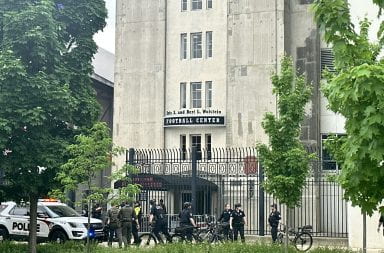Students studying late into early morning, or working late on campus have a safe way to get home if they plan ahead.
In 2010, Capt. David Rose of the Ohio State Police said Student Safety Service escorted 24,133 students.
“That is a 9 percent increase from the year before, with no increase in university funding,” he said.
Rose, who has been on the oversight role of the Student Safety Service since January 2004, said it’s been a challenge for the service to accommodate the increase in student usage.
“Ten years ago the number was less than half what it is now,” he said. “It’s been a constant increase every year.”
Rose said the service is primarily paid for through general university funds and the budget remains relatively constant.
“Right now our full budget is $255,253.79 per year, not including paying for hiring a new full-time employee. It was around $225,000 in 2004 when I started.”
Rose did not provide statistics for a breakdown of the budget, but said 7,641 gallons of fuel were used in 2010.
Besides fuel, the budget includes Student Safety Service officer wages and maintenance on the vehicles.
Rose said the service has been looking for ways to increase efficiency, with the most recent funding increase leading to a new full-time employee and coordinator for the service.
Sean Bolender, program coordinator since April 2009, started as a student driver in 2004. He said 15-30 Student Safety Service officers are employed at a time, and pointed out that all the van drivers are students.
“We always have two officers in the van at one time. We want to make sure they take care of each other and also it comforts the person they are escorting,” Bolender said.
Of the students transported, neither Rose nor Bolender sees a specific trend or demographic.
“We keep track of the names of the riders, but we don’t keep any statistics or trends,” Rose said.
Statistics examining the effectiveness of the escort service are also lacking.
Clery Reports, OSU-provided crime statistics, only trace back as far as 1998, two years after the service was put into place. Also, the 2010 report will not be made available until October 2011. The Clery Report does not show statistics for the entire University District.
However, the reports show that aggravated assault on campus greatly declined from the 26 and 29 reported crimes in 1998 and 1999, respectively, to an average of just more than three reported crimes per year from 2000 to 2009.
The crime numbers for robbery and sexual offenses appear relatively constant the last 10 years. However, there was a steep decrease from 26 sexual offenses in 2008 to 13 in 2009.
Rose warns the numbers can be misleading.
“It is tricky to try and draw any kind of conclusion. The records don’t go back to before the service started, and even if they did, the service was a different form then,” Rose said. “They did escorts, but not nearly as many as now.”
Rose also said while the safety services might directly impact some statistics, such as aggravated assault, robbery and sexual offenses, other crimes might be indirectly impacted.
“The drivers are in direct connection to the university police and can report suspicious activity, through lot and building checks and so on,” he said.
Sgt. Shaun Laird of the Columbus Police Department’s robbery squad, said it is hard for him to estimate the effectiveness of the service as well.
“I know they are doing a lot; the officers are very available to students, I think they have most of the bases covered,” Laird said.
Despite lacking tangible statistics to prove effectiveness, Rose and Bolender are content with the positive impact.
“Regardless of what service we offer, there will be a demand based on the population of the university,” Rose said.
Rose said most importantly, students must plan for their own safety.
“Be patient. Call as far in advance as you can after the service opens,” Rose said. “Plan ahead and don’t put yourself in a situation where the service is your only option.”
A common complaint among students is the wait time for an escort.
Emily Fetterman, a second-year in early childhood education, has used the service multiple times. Fetterman said her job at Sloopy’s Diner offered arrangements for escorts for its employees because of the late hours the employees worked.
“I called one time and there was a three-hour wait,” Fetterman said. However, Fetterman pointed out that she called at 11:00 p.m., several hours after the night’s escorts began.
Rose acknowledges the service is busy most nights. He also pointed out the service only has five vans, with a sixth currently out of commission.
“The service was designed to be a secondary source of transportation,” Rose said. “Students should be an active participant in their safety and plan ahead. There are other options, such as knowing the bus schedules.”
Although the van escorts are busy, the drivers are time-efficient, Bolender said.
“If it is a slow night, the students either do impromptu rides or even do building and lot checks, unsolicited. They are very active and committed.”
Garrett Nunn, a first-year in Spanish, was the recipient of an impromptu ride.
“My friends and I were walking back to our dorms from off campus, and a van stopped and asked if we needed a ride,” Nunn said.
Nunn said he would recommend the service and thinks it is a good resource for students.
Bolender sees a benefit for the student drivers as well.
“The students we have, 90 percent are criminology or security and intel majors. We have people getting hired or placed in academies because of their work experience,” Bolender said. “There is a lot of value in this job for work experience and networking.”
Rose said the first student employees were hired as the “eyes and ears” on campus to contact the OSU Police.
“The escort service with the vans was put into place around 1996,” he said. “The goal was for students to not be forced to walk alone at night.”
Rose said vans are used for escorts now, but the service used to offer on-foot escorts.
“We found a lot of people aren’t open to foot escorts,” he said.
Escorts are offered from 6 p.m. to 3 a.m. Winter Quarter, and from 7 p.m. to 3 a.m. Spring, Summer and Autumn quarters.


